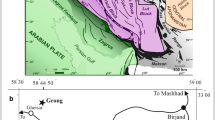Abstract
A mass occurrence of peculiar centric diatoms was found in a freshwater diatomite included in Miocene deposits of the Rhoen mountains in Central Germany. Similar forms were determined asMelosira jouseana in the literature. However, detailed observations in the LM and SEM exhibit morphologic characteristics which are completely unknown inMelosira and inAulacoseira. Regular triangulate and trilobate outlines of the valve faces occur and dominate besides circular ones. Variable support partitions and pillars are inserted between discus and Ringleiste. Such stabilizing elements are lacking in all comparable recent and known fossil genera. Instead of the extensive cingulum inAulacoseira the cells possess only a single copula which encloses the very short collum. A structure (l“fringe-curtain“) starting from the distal margin of this copula covers like a grid the mantle of the associated valve. Sulcus and pseudosulcus do not occur and rimoportulae or fultoportulae were not observed. Therefore a new genus is introduced with a new species,Miosira rhoenana. Miosira jouseana in the new combination is based onMelosira jouseana Moiseeva 1971.
Kurzfassung
Eine Einschaltung eines limnischen Diatomits innerhalb miozäner Ablagerungen der Rhön enthält Massenvorkommen eigentümlicher zentrischer Diatomeen. Ähnliche Diatomeen-Formen wurden in der Literatur alsMelosira jouseana beschrieben. Eingehende Untersuchungen mit dem Licht- und Rasterelektronenmikroskop zeigen jedoch morphologische Merkmale, die beiMelosira und auch beiAulacoseira völlig unbekannt sind. Es kommen regelmäßige triangulate und trilobate Schalenumrisse vor, die gegenüber den kreisrunden Formen dominieren. Variable Stützwände und Pfeiler sind zwischen dem Discus und der Ringleiste eingeschaltet. Derartige Stützelemente fehlen bei allen vergleichbaren bekannten fossilen und rezenten Gattungen. Anstelle des ausgedehnten Cingulums beiAulacoseira besitzen die Zellen hier eine einzelne Copula, die das sehr kurze Collum umschließt. Eine Struktur, die vom distalen Rand des Gürtelbandes ausgeht, bedeckt den Mantel der zugehörigen Schalenhälfte wie mit einem „Fransenvorhang“. Es gibt weder einen Sulcus noch Pseudosulcus; außerdem wurden keine Rimoportulae und Fultoportulae beobachtet. Aus diesen Gründen wird eine neue Gattung mit einer neuen ArtMiosira rhoenana aufgestellt.Miosira jouseana wird neu kombiniert und basiert aufMelosira jouseana Moiseeva 1971.
Similar content being viewed by others
Literatur
Bethge, H. 1925.Melosira und ihre Planktonbegleiter. - Pflanzenforschung3: 1–82, Jena.
Bradbury, J.P. &Krebs, W.N. 1982. Neogene and quaternary lacustrine diatoms of the Western Snake River Basin Idaho-Oregon, USA. - Acta Geologica Academiae Scientiarum Hungaricae25 (1–2): 97–122, Budapest.
Crawford, R.M. 1981. Some considerations of size reduction in diatom cell walls. - Proceedings of the Sixth International Diatom Symposium Budapest1980: 253–266, Königstein.
Gibson, C.E.;McCall, R.D. &Dymond, A. 1993.Skeletonema subsalsum in a freshwater Irish lake. - Diatom Research8: 65–71, Bristol.
Glezer, Z.I.;Makarova, I.V.;Moiseeva, A.I. &Nikolaev, V.A. 1992. Diatomovye vodorosli SSSR, iskopaemye i sovremennye2(2): 1–128, St. Petersburg (Nauka).
John, J. &Economou-Amilli A. 1991. Morphology and ultrastructure of the centric diatomCyclotella distinguenda. - Diatom Research6: 307–315, Bristol.
Krammer, K. &Lange-Bertalot, H. 1991. Bacillariophyceae. - [In:]Pascher, A. [ed.] Süßwasserflora von Mitteleuropa2(3): 1–576, Stuttgart.
Moiseeva, A.I. 1971. Atlas of the Neogene diatomaceous deposits of the Primorskova Region. - Trudy Vsesojuznogo nautsno-issledovatelnogo geologitseskogo instituta, new series171: 1–151, Leningrad.
Moiseeva, A.I. &Nevretdinova, T.L. 1990. Novye semejstvo i rod presnovodnykh iatomovykh vodoroslej (Bacillariophyta). - Botaniceskij zumal75: 539–544, St. Petersburg (Nauka).
Schiller, W. 1991. Geologische Untersuchungen in der Umgebung von Hausen und Rüdenschwinden, Blatt 5426 Hilders, Rhön. -Unveröffentlichte Diplom-Arbeit der Universität Frankfurt/M.: 131 S., Frankfurt/M.
— 1994. Miozäne Diatomeen von der Guckas bei Rüdenschwinden/Rhön. - Beiträge zur Naturkunde in Osthessen29: 35–47, Fulda.
Servant-Vildary, S.;Paicheler, J.C. &Semelin, B. 1988. Miocene lacustrine diatoms from Turkey. - Proceedings of the Ninth International Diatom Symposium Bristol1986: 165–181, Königstein.
Author information
Authors and Affiliations
Rights and permissions
About this article
Cite this article
Krammer, K., Lange-Bertalot, H. & Schiller, W. Miosira rhoenana n. gen. n. sp. (Bacillariophyceae) aus miozänen limnischen Sedimenten der Rhön im Vergleich mit anderen zentrischen Diatomeen. Paläontol Z 71, 5–18 (1997). https://doi.org/10.1007/BF03022543
Received:
Accepted:
Issue Date:
DOI: https://doi.org/10.1007/BF03022543




